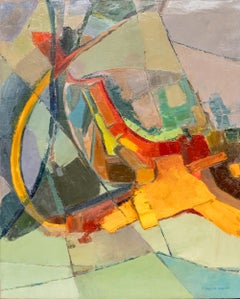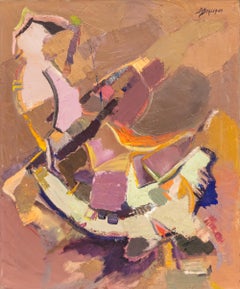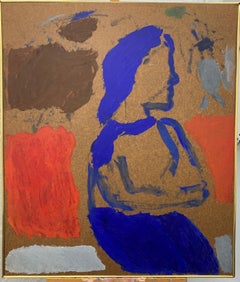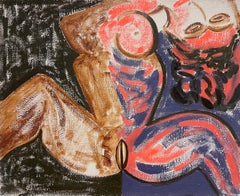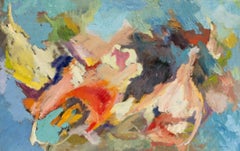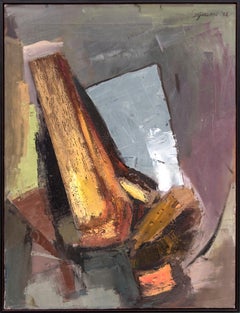Florence Graziano Abstract Paintings
American, 1913-1996
Florence Mercolino Graziano was a painter and sculpture who worked in charcoal, clay, ivory, oils, ceramics and watercolors. Her subject matter primarily consisted of figurative work, floral motifs, still life, portraits and landscapes. She was born in Plainfield, New Jersey in the early 20th Century, before 1950 (exact date unknown). Florence Mercolino Graziano’s artistic talents were recognized at the early age of five by her school teachers who noticed her ability to draw immediately. From that time on she continued to paint with watercolor, pastels and began carving Ivory Soap Bars and oil painting by the age of ten.
After graduating from Mt. St. Mary’s in Watching, New Jersey, Graziano studied art at Columbus College of Art and Design, Columbus, Ohio. She furthered her training at the Art Students League of New York under the Dean of Figurative Painters, Robert Brackman; Curator of American Art at the Metropolitan Museum of Art, Robert Beverly Hale; Roberto De Lamonica, graphics and sculpture and John Hovannes. She also studied at The Cape School of Art under Henry Hensche in Provincetown, Massachusetts.
Florence Mercolino Graziano received an Honorary Doctorate of Philosophy Degree by Colorado State Christian College in 1973 and is currently Director--instructor of the Graziano School of Fine Art which she founded in her hometown studio of Plainfield, New Jersey. Florence Graziano is a member of the American Artists Professional League, Catherine Lorillard Wolfe Club, NYC; the Hudson Valley Art Association and the National Arts Club. She is also, listed as Who’s who in the Arts and Artists/USA.
Graziano taught and lectured privately in her own art schools since 1962. She also wrote and illustrated children’s books and authored an article for the 1978 issue of the American Artist Magazine, titled “The Studio Art Workshop”. She currently lives in Plainfield, New Jersey with her husband Muhlenberg Hospital anesthesiologist Dr., Natale Graziano.
Exhibited: Washington County Museum of Fine Arts, Maryland; Bullocks Wilshire, Los Angeles; Chase Gallery, N.Y.C.; the Salon de la Societe de L'Ecole Francaise at the Museum of Modern Art, Paris France as one of 15 artists selected to represent the United States in the 1971-1972 Exposition.
Further Reading: The Artists Bluebook: 34,000 North American Artists to March 2005, Lonnie Pierson Dunbier of AskArt.com Inc. 2005, Who’s Was Who in American Art, 1564-1975, Peter Hastings Falk, Sound View Pr; First Edition edition, June 1999, Who’s Who in American Art, Jaques Cattell Press, 12th edition, 1976
©David Cook Galleries, LLCto
2
Overall Width
to
Overall Height
to
2
1
1
2
2
2
2
2
664
619
464
342
2
2
2
Artist: Florence Graziano
1960s Mid-Century Abstract Expressionist Oil Painting in Primary Colors
By Florence Graziano
Located in Denver, CO
This original 1960s oil on canvas by American artist Florence V. Mercolino Graziano exemplifies the dynamic energy of the Abstract Expressionist movement. The composition showcases b...
Category
1960s Abstract Expressionist Florence Graziano Abstract Paintings
Materials
Oil
Florence Mercolino Graziano “Galaxie #122” 1971 Abstract Oil on Canvas
By Florence Graziano
Located in Denver, CO
Galaxie #122 (1971) is a striking abstract oil painting by American artist Florence Mercolino Graziano, showcasing a sophisticated interplay of mauve, violet, and golden yellow layer...
Category
1970s Abstract Expressionist Florence Graziano Abstract Paintings
Materials
Oil
Related Items
"Crossed Arms" Mid Century Abstract Expressionist NYC Female Artist
By Sylvia Rutkoff
Located in Arp, TX
Sylvia Rutkoff (1919-2011)
Sr5-1
c.1960s
“Crossed Arms”
Acrylic on Masonite
36x42 period frame
Unsigned
Collection acquired from family estate
Category
Mid-20th Century Abstract Expressionist Florence Graziano Abstract Paintings
Materials
Masonite, Oil
$4,000
H 36 in W 42 in D 2 in
French 20th Century Abstract Nude Portrait of Lady Picasso Style Work & Period
Located in Cirencester, Gloucestershire
Abstract Expressionist Portrait of Nude Lady
by Gilbert Pelissier (French born 1924)
signed, circa 1960's-1970 period
oil painting on canvas, unframed
canvas size: 20 x 24 inches
con...
Category
Mid-20th Century Abstract Expressionist Florence Graziano Abstract Paintings
Materials
Canvas, Oil
$1,131 Sale Price
30% Off
H 20 in W 24 in
Blue Expressionism - Oil On Canvas by Giorgio Lo Fermo - 2020
By Giorgio Lo Fermo
Located in Roma, IT
Blue Expressionism is an original artwork realized by Giorgio Lo Fermo (b. 1947) in 2020.
Original Oil Painting on Canvas.
Hand-signed, dated and titled on the back.
Hand-signed a...
Category
2010s Abstract Expressionist Florence Graziano Abstract Paintings
Materials
Canvas, Oil
$1,550
H 19.69 in W 23.63 in D 1.19 in
City Drive Abstract Expressionist Painting by Leading British Urban Artist
By Angela Wakefield
Located in Preston, GB
City Drive Abstract Expressionist Painting - a rare early work from Leading British Urban Artist, Angela Wakefield. Entitled 'City Drive', this moody and atmospheric artwork is from ...
Category
1990s Abstract Expressionist Florence Graziano Abstract Paintings
Materials
Gesso, Acrylic, Oil, Mixed Media, Cotton Canvas, Varnish, Paint, Cotton,...
$43,636 Sale Price
20% Off
H 24 in W 27 in D 2 in
Very Large French 20th Century Blue Textured Abstract Composition Painting
Located in Cirencester, Gloucestershire
Abstract Expressionist Composition
by Gilbert Pelissier (French born 1924)
signed oil painting on canvas, unframed
inscribed verso
dated 68'
canvas size: 35 x 46 inches
condition: ov...
Category
Late 20th Century Abstract Expressionist Florence Graziano Abstract Paintings
Materials
Canvas, Oil
$1,765 Sale Price
30% Off
H 35 in W 46 in
Abstract Composition - Oil On Canvas by Giorgio Lo Fermo - 2020s
By Giorgio Lo Fermo
Located in Roma, IT
Abstract Composition is an original artwork realized by Giorgio Lo Fermo (b. 1947) in 2021.
Original Oil Painting on Canvas.
Hand-signed, titled and dated on the back of the canvas...
Category
21st Century and Contemporary Abstract Expressionist Florence Graziano Abstract Paintings
Materials
Canvas, Oil
$1,430
H 27.56 in W 19.69 in D 0.04 in
"Ballerina" Oil Painting 35" x 27" inch by Anastasiia Danilenko
By Anastasiia Danilenko
Located in Culver City, CA
"Ballerina" Oil Painting 35" x 27" inch by Anastasiia Danilenko
Ships rolled in a tube
Anastasiia Danilenko is an artist and graphic designer.
But the area of her occupation is p...
Category
21st Century and Contemporary Abstract Expressionist Florence Graziano Abstract Paintings
Materials
Canvas, Oil
"Restraint" Oil Painting 43" x 35" inch by Anastasiia Danilenko
By Anastasiia Danilenko
Located in Culver City, CA
"Restraint" Oil Painting 43" x 35" inch by Anastasiia Danilenko
Ships rolled in tube
Anastasiia Danilenko is an artist and graphic designer.
But the area of her occupation is pain...
Category
21st Century and Contemporary Abstract Expressionist Florence Graziano Abstract Paintings
Materials
Canvas, Oil
Bright & Colourful Overlapping Circles Abstract French 20th Century Painting
Located in Cirencester, Gloucestershire
Abstract Expressionist Composition
signed by Gilbert Pelissier (French born 1924)
oil painting on canvas, unframed
canvas size: 35 x 45.75 inches
condition: overall very good, a few ...
Category
Late 20th Century Abstract Expressionist Florence Graziano Abstract Paintings
Materials
Canvas, Oil
"Mia" Painting 35" x 28" inch by Vladislav Chenchik
Located in Culver City, CA
"Mia" Painting 35" x 28" inch by Vladislav Chenchik
Artwork ships rolled in tube.
Vladislav Chenchik is a contemporary artist from Ukraine. His artwork combines abstract and reali...
Category
21st Century and Contemporary Abstract Expressionist Florence Graziano Abstract Paintings
Materials
Canvas, Oil, Acrylic
"Iv" Painting 35" x 28" inch by Vladislav Chenchik
Located in Culver City, CA
"Iv" Painting 35" x 28" inch by Vladislav Chenchik
Ships rolled in tube
Vladislav Chenchik is a contemporary artist from Ukraine. His artwork combines abstract and realistic styles...
Category
21st Century and Contemporary Abstract Expressionist Florence Graziano Abstract Paintings
Materials
Canvas, Oil, Acrylic
"AD 2.23" Abstract Painting 71" x 79" inch by Ahmed Dafrawy
By Ahmed Dafrawy
Located in Culver City, CA
"AD 2.23" Abstract Painting 71" x 79" inch by Ahmed Dafrawy
Dafrawy’s fine arts academic background started in 2014 when he received the certificate of drawing course completion fr...
Category
21st Century and Contemporary Abstract Expressionist Florence Graziano Abstract Paintings
Materials
Canvas, Oil
Previously Available Items
Colorful Abstract Expressionist Oil by Florence V. Mercolino Graziano
By Florence Graziano
Located in Denver, CO
This original abstract oil painting by female artist Florence V. Mercolino Graziano is a vibrant and expressive composition full of color and energy. The work features dynamic brushw...
Category
Mid-20th Century Abstract Expressionist Florence Graziano Abstract Paintings
Materials
Oil
H 51.5 in W 33.5 in D 2 in
Abstract in Green & Orange, 1960s Mid Mod Abstract Textured Oil Painting
By Florence Graziano
Located in Denver, CO
"Abstract in Green & Orange" is an original vintage 1968 abstract painting by 20th century woman artist, Florence Graziano (1913-1996). Signed and dated by the artist in the upper right corner, titled verso. Painted in oil on canvas in colors of Yellow, Red, Orange, Blue, & Green. Presented in a vintage in a black frame, outer dimensions measure 24 ½ x 18 ½ x 1 ⅝. Image dimensions measure 24 x 18 inches.
Expedited and international shipping is available - please contact us for a quote.
About the Artist:
Florence Mercolino Graziano was a painter and sculpture who worked in charcoal, clay, ivory, oils, ceramics and watercolors. Her subject matter primarily consisted of figurative work, floral motifs, still life, portraits and landscapes. She was born in Plainfield, New Jersey in the early 20th Century, before 1950 (exact date unknown). Florence Mercolino Graziano’s artistic talents were recognized at the early age of five by her school teachers who noticed her ability to draw immediately. From that time on she continued to paint with watercolor, pastels and began carving Ivory Soap Bars and oil painting by the age of ten.
After graduating from Mt. St. Mary’s in Watching, New Jersey, Graziano studied art at Columbus College of Art and Design, Columbus, Ohio. She furthered her training at the Art Students League of New York under the Dean of Figurative Painters, Robert Brackman; Curator of American Art at the Metropolitan Museum of Art, Robert Beverly Hale; Roberto De Lamonica...
Category
1960s Abstract Florence Graziano Abstract Paintings
Materials
Oil
H 24.5 in W 18.5 in D 1.625 in
Florence Graziano abstract paintings for sale on 1stDibs.
Find a wide variety of authentic Florence Graziano abstract paintings available for sale on 1stDibs.
